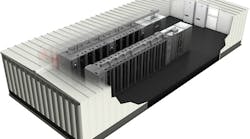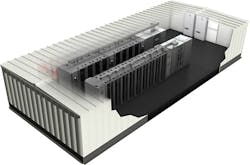Article 646, one of the new Articles in the 2014 Edition of the NEC, provides the requirements for modular data centers. As with the other new Articles when first introduced, it’s not very long.
What exactly is a modular data center (MDC)? The NEC definition [646.2] is short (see NEC Defines Modular Data Center). For our purposes, think of it as a “data center in a box.” It’s a box large enough to contain information technology (IT) equipment racks yet small enough to be moved by road to a site. It’s not built in place, as is the traditional data center, but is shipped to the location.
Because of its relatively small unit size, the MDC has scalability and lead time advantages over its traditional counterpart. These two advantages combine to permit “just in time” deployment, so capital can be invested close to the actual need. From a corporate executive’s viewpoint, this makes cash flow look good; that’s one big reason MDC sales have been on a fairly steep upward trajectory.
An MDC is designed to be as self-contained as possible. But it’s not the case that you wheel it up and plug it in. The installation is more complicated than that, thus leading to the need for an NEC Article addressing the minimum requirements.
Other NEC Articles apply
Many NEC Articles have a relatively short subsection listing other Articles that may be applicable. About 25% of Art. 646 is devoted to identifying other applicable Articles and explaining how they apply [646.3(A)-(N)]. This may seem crazy, until you consider that this is really a “data center in a box” — and that box has data center-type connections to the outside world.
Although anyone installing an MDC must review all of the references to applicable Articles, the last one is crucial. You must provide an approved means of disconnecting power to all electronic equipment, following the requirements of Sec. 645.10 [646.3(N)]. Article 645 contains the requirements for information technology equipment (ITE). This particular requirement exists mainly to facilitate shutdown by first responders.
Oddly enough, 646.3(N) repeats part of 645.10 with rewording to make it MDC-specific. This isn’t necessary, because 646.3(N) already says the MDC must comply with 645.10.
Listed and labeled
The next subsection may also seem confusing, but for a different reason. All MDCs must conform to one of the following:
1) Be listed and labeled, and comply with 646.3(N) and 646.5 through 646.9, or
2) Comply with the provisions of Art. 646.
It would have been nice for workflow purposes if this fork in the road had been offered up much earlier in this new Article. But remember, the NEC is not a design manual [90.1]. You need to read, or at least scan through, an applicable Article in its entirety before trying to apply it.
As you do this, it may be helpful to keep a running list of applicable sections or subsections. Or you can use this old school method: Remove the relevant pages from your NEC loose-leaf binder, photocopy them, and then highlight on the paper what’s applicable.
So what does this fork in the road mean for your MDC installation project? If you install an MDC that isn’t listed and labeled, you must apply all the requirements of Art. 646. But if it’s listed and labeled, you have a much smaller set of requirements to refer to. That’s one key advantage of a listed and labeled system.
A disadvantage of a listed and labeled system may be higher purchase cost, but not necessarily. There are economies that come with standardized packages, and those economies may offset the listing and labeling costs. Further offsetting this disadvantage (if it exists), you reduce installation headaches by having far fewer issues (including Art. 646 requirements) to deal with.
Ultimately, what may drive the purchase decision is the turnaround time from ordering date to startup. A listed and labeled system will nearly always have a much shorter turnaround time, partly because so much engineering is done upfront. Let’s look at some other requirements that listed and labeled systems must meet, and then look at the additional requirements for systems that aren’t listed and labeled.
Some requirements for all MDCs
You must provide a means to disconnect power to all electronic equipment in the MDC per 645.10. Use a similar means to disconnect power to all dedicated MDC HVAC systems that cause the required smoke/dampers to close.
Every MDC must have a plainly visible, permanent nameplate attached to each equipment enclosure denoting information such as the supply voltage, full-load current, and the electrical drawing numbers [646.5]. Whether certain data must be on the nameplate depends upon whether the MDC is powered by a separate service or not. Discuss this factor with the manufacturer’s rep before finalizing the order.
Size the supply conductor(s) to have an ampacity at least 125% of the full-load current rating [646.6]. If the MDC comes with overcurrent protection, size the overcurrent protection for the service conductors per 230.90 through 230.95.
You can use flexible power cords and cables to connect MDC enclosures but only where not subject to damage [646.9(A)]. For example, you can’t run them across a driveway. You can’t use them to connect to external sources of power, either [646.9(B)]. Any flexible cords or cables you do use must be listed for extra-hard usage. If used outdoors, they must be sunlight resistant and listed for use in wet locations [646.9(C)]. Single-conductor power cables must be 2 AWG or larger.
Lighting and equipment requirements
Requirements for MDCs that aren’t listed and labeled are outlined in Parts II (Equipment), III (Lighting), and IV (Workspace) of Art. 646. The workspace requirements are extensive, so we’ll come back to those momentarily.
The lighting requirements are basically common sense. You have to provide lighting for workspaces and exit access. You also must provide emergency lighting, and you can’t run non-emergency equipment from the emergency lighting circuits [646.17].
Equipment used to supply and/or distribute power in an MDC must comply with Art. 110, Parts I and II [646.10]. You can’t use electric utility-owned transformers in an MDC [646.11]. Any transformers you do install must be of the dry type and must conform to the requirements of Art. 450. Other equipment must be listed and labeled for the particular use, though not necessarily for MDC use [646.13, 646.14].
You must install at least one convenience receptacle in each work area of the MDC so that test equipment can be operated without routing flexible power cords unsafely (such as across doorways) [646.12]. This routing condition means that simply installing one receptacle may not be enough. Determine what kind of testing is required for maintenance, and install enough receptacles so that it can be done without running cords from receptacles outside the work area.
Workspace
When installing MDCs that are listed and labeled, you presumably don’t need to refer to Parts II, III, and IV. But workspace requirements are routinely chipped away at, and violations are common. While the listed and labeled MDC will be designed and delivered fully compliant with Part IV, you must ensure it stays that way.
In writing its regulations 29CFR1926, Subpart K, OSHA sourced and referenced the NEC, thus making things like NEC space requirements statutory law. Often, site owners fixate in the imaginary “3-ft rule” while ignoring the opening statement of 110.26.
That statement requires enough space to permit ready and safe operation of the equipment. The actual dimensions given in the OSHA and NEC tables do include 3 ft (and greater), but conditions may require exceeding the table dimensions.
With MDCs, there’s the extra condition of adequate and unobstructed egress [646.19]. Part IV ends with an amplification of the opening statement of 110.26.
Avoid MDC pitfalls
An MDC can save you considerable cost in terms of engineering and installation, especially if it’s listed and labeled. But it’s not a plug-and-play system. Other considerations are also critical to a successful installation. But with a little diligence and planning upfront, your MDC installation can be problem-free.
Lamendola is an electrical consultant located in Merriam, Kan. He can be reached at [email protected].
SIDEBAR: NEC Defines Modular Data Center
The NEC says modular data centers (MDCs) are “Prefabricated units, rated 600V or less, consisting of an outer enclosure housing multiple racks or cabinets of information technology equipment (ITE) (e.g., servers) and various support equipment, such as electrical service and distribution equipment, HVAC systems, and the like.”
This is followed by four Informational Notes. It’s a lot of text, but it helps give you a better idea of what an MDC is. MDCs come in various form factors, such as:
• Pods (similar to the storage/moving pods that you may have seen in residential
driveways).
• Steel buildings (often called blocks, they resemble tool sheds).
• Shipping container (a standard ISO intermodal shipping container; think tractor-trailer without the tractor).






